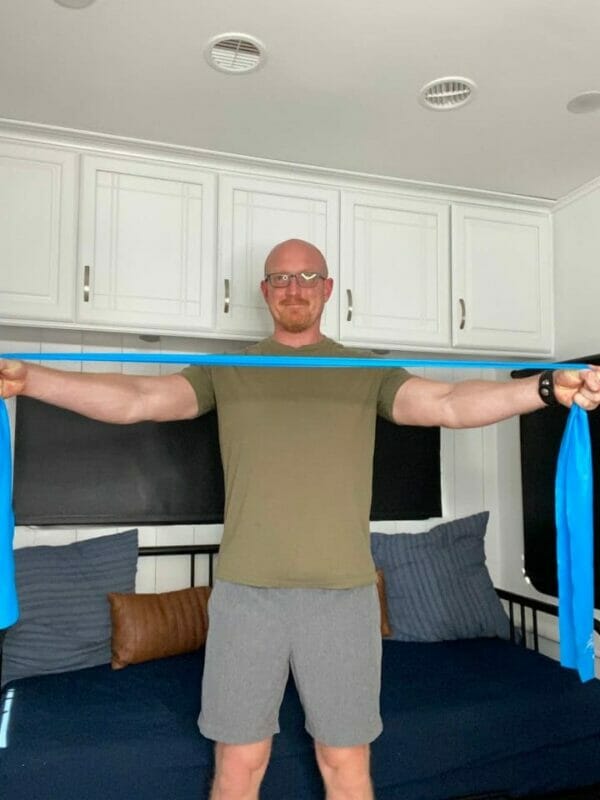Free download: Top 10 Natural & Easy Remedies for Joint Pain from Home. Learn these helpful remedies.
Estimated Reading Time: 11 minutes read
Have you ever wondered what the best exercise for shoulder tendonitis is?
There are actually quite a few to consider!
Having the right kind of exercise program for the shoulder is one of the most important things for best tendonitis recovery.
Exercise will help to promote blood flow and circulation, move healing nutrients to the injured shoulder, and give the right kind of muscle and tendon stimulation for recovery.
Knowing the best exercises to do for shoulder tendonitis can be confusing at first, but important to know in order to help your shoulder heal as fast as possible.
Table of Contents
What is Shoulder Tendonitis?

Shoulder tendonitis is an injury in the shoulder that causes pain and inflammation.
This condition can happen to any muscle-tendon unit in the shoulder, such as the rotator cuff, biceps and deltoid muscles.
When a tendon or tendons become inflamed, they become thickened, which can affect the way they move and support the shoulder. As a result, the shoulder becomes painful when you try to move it.
What Causes Shoulder Tendonitis?
There are a few things that can increase your chances of developing shoulder tendonitis:
1. Repetitive use
Overuse of the shoulder is one of the most common causes of shoulder tendonitis. This is especially true if overuse occurs with overhead motions.
Maybe you were hanging up Christmas lights for the holidays. Or you had to paint that new room with super tall ceilings.
You might have even started noticing a little shoulder pain during these activities, but the job had to get done, right??
Athletes will also commonly experience shoulder tendonitis if their sport requires a lot of repetitive upper body movements, such as with baseball players or swimmers.
2. Heavy Lifting
Jobs or tasks that require heavy lifting, especially if done repetitively, can cause shoulder tendonitis.
You’re considered to be at an even higher risk if you’re doing all of this heavy lifting with relatively weak shoulder muscles to begin with.
The heavy repetitive tasks can place continuous stress and strain on the shoulders, leading to the potential of them getting over-worked and irritated.
3. Age
Your risk of experiencing shoulder tendonitis will usually increase with age.
This combined with the fact that tendons actually have pretty poor healing abilities, makes shoulder tendonitis recovery more challenging the older you are.
As we get older, changes in the structure and make-up of our tendons can affect the way they function. In addition to this, if not properly exercised, the shoulder muscles will tend to get weaker as we get older.
If you have weak shoulder muscles, plus consider the natural aging effect on the tendons, overuse or incorrect use of the shoulders can cause tendonitis.
4. Weak Shoulders
While we did just mention that weaker shoulder muscles are more commonly found as we age, there are plenty who are younger with weak shoulder muscles as well!
Shoulder weakness ultimately can develop in anyone of any age if the right exercise routine isn’t in place.
When your shoulders are weaker, and then you use them repetitively or lift something heavy that you probably shouldn’t have been lifting in the first place, this can greatly strain those weaker muscles.
As a result, abnormal stress is placed on the attaching tendons, leading to inflammation and pain.
5. Shoulder Trauma or Another Shoulder Injury
Any type of shoulder injury or trauma could increase your odds of developing shoulder tendonitis if that injury never healed properly.
A trauma could involve a fall, direct blow to the shoulder, etc. Another shoulder injury that could lead to tendonitis if not taken care of right away might include shoulder bursitis, frozen shoulder, or a rotator cuff tear.
If you already have or had a shoulder injury that hasn’t been properly rehabbed, then you are more likely to develop tendonitis compared to someone who took the right steps to recover from their injury in the first place.
Shoulder Tendonitis Symptoms

While shoulder tendonitis may vary a little bit from person to person, depending on which muscle-tendon unit is inflamed, most will experience the following symptoms:
- Pain when using the arm, especially overhead
- Pain may be a dull ache or a sharp sensation
- Pain improves with rest
- Shoulder tenderness
- Swelling and warmth
- Shoulder stiffness
- Shoulder weakness
- Decreased range of motion
One of the most important things to remember with shoulder tendonitis is that while you don’t want to completely avoid using the affected shoulder, you don’t want to keep overusing it either!
If you continue to overuse it, you’ll keep experiencing the above symptoms.
Exercises for Shoulder Tendonitis
While it’s a good thing to rest the shoulder for a few days after developing tendonitis, starting the right kind of exercise program will help your recovery move along more quickly.
Effective exercises for shoulder tendonitis will gently stimulate the painful and inflamed tendons, without causing more pain and irritation.
The best shoulder tendonitis exercises will usually involve a combination of strengthening exercises and stretching exercises, just like with the following examples.
For any strengthening exercises, we’ll be using something light weight. While you can use a free weight or dumbbell, most of the below strengthening exercises will be easiest to do with a light resistance band.
You can practice each strengthening exercise with both arms or just the one arm that’s injured. For simplicity, we’ll demonstrate with both arms.
1. Rows
- Attach your resistance band around something sturdy, like a doorknob.
- Begin with the arms stretched in front of you and the palms facing each other.
- There should be a little tension on the band.
- Keeping a tall posture, bend the elbows as you swing and pull back. Keep the elbows close to your side at the end of the motion.
- Squeeze your shoulder blades together throughout the exercise.
- Hold for 2 seconds, then slowly return to your starting position.
- Repeat the exercise 10-15x for 2 sets.


2. Shoulder Pullbacks
- A shoulder pullback is similar to a row, however, instead of swinging the arms back with the elbows bent, the elbows will remain straight for this exercise.
- With your resistance band attached to something sturdy, hold the ends of the band with the arms extended in front of you.
- Keep the palms facing down towards the floor.
- Gently pull the arms straight down and back. You’ll want to try to squeeze your shoulder blades down and back also, as if pushing them down towards your back pockets.
- Hold the arms by your side for up to 2 seconds, then slowly raise them back to where you started.
- Repeat 10-15x for 2 sets.


3. Horizontal Abduction
- Hold your resistance band in each hand. Keep your hands shoulder width apart.
- With the arms stretched in front of you, raise them to shoulder height.
- The palms should be facing each other.
- As you squeeze your shoulder blades together, open the arms apart from each other. Don’t push the range of motion beyond the point of your shoulders themselves.
- Hold for up to 2 seconds, then allow the arms to return to your starting position.
- Repeat the exercise 10-15x for 2 sets, while keeping the arms elevated the whole time.


4. External Rotation
- Shoulder external rotation is excellent for strengthening the rotator cuff muscles.
- While holding the elastic band in your hands, keep each elbow bent about 90 degrees and tucked by your side.
- The palms will be facing each other with the hands about waist level.
- While you squeeze your shoulder blades together, slowly rotate the arms away from each other. While you’ll see the forearms moving, the motion is actually coming from the shoulders.
- Hold at the end of the motion for up to 2 seconds, then slowly return to your starting position.
- Repeat 10-15x for 2 sets.


5. Shoulder Diagonals
- Shoulder diagonals are a great way to work multiple muscles around your shoulder blades.
- You’ll perform shoulder diagonals in two different positions, as you can see in the above pictures.
- Begin in the same position you were in for horizontal abduction. Holding the band, have the arms stretched in front of you with the palms facing each other.
- Now, instead of opening the arms directly apart from each other, you’ll open them on a diagonal. One arm will move into an upward diagonal, while the other arm moves into a downward diagonal at the same time.
- You’ll open and close the arms in and out of these diagonals 10-15x for 2 sets. Make sure to squeeze your shoulder blades together with each repetition.
- Once you’ve finished with one diagonal, you’ll reverse it. This means the arm that was in an upward diagonal will move down and vice versa.



Since this one might feel a little tricky at first, here’s a video demonstration to show the transition from one diagonal to the other.
6. Pec Stretch
Now we’ll take a look at a couple of easy stretches to help your shoulder pain!
A pec stretch is a classic go-to stretch for the pec muscles in the front of the chest and shoulders.
All you need is a doorway for this one.


- Standing in front of your doorway, raise the arms up to shoulder height like a goal post. The elbows will be bent with the palms facing forward.
- Keeping this position, rest the arms against your doorway.
- Slowly lean forward into a gentle stretch and hold for at least 30 seconds. Repeat twice.
7. Shoulder Adduction Stretch


This cross body stretch is great to stretch the back, or posterior, shoulder.
- Begin with the injured arm stretched out in front of you. Take the opposite arm and hook it under the arm to be stretched.
- Slowly pull the affected arm across your chest until a stretch is felt in the back of the shoulder. Make sure the shoulder stays down and relaxed during this.
- Hold at least 30 seconds. Repeat twice.
Sometimes part of the problem with shoulder tendonitis is having a tight upper back. A tight upper back can very much limit your shoulder range of motion and make your shoulder pain worse when trying to use it.
Check out this easy foam rolling technique for the upper back. It’s a great addition to your stretches in your home program for the shoulder!
Rehab for Shoulder Tendonitis
Many times, your doctor will refer you to physical therapy or occupational therapy to help rehab your shoulder tendonitis.
Your therapist can help guide your exercises, and make sure you’re not over-doing things.
In addition to an exercise routine, recovery for the shoulder will move along more quickly when the therapist is able to incorporate manual therapy and other tools to help the shoulder heal.
Manual therapy techniques, like trigger point release and mobilization with movement, can help calm down irritated soft tissues. By doing this, you’ll improve your shoulder’s tolerance for movement and exercise.
Other tools that might be used to reduce inflammation and pain include low level laser therapy, ultrasound, taping, and more.
Taping has the potential to provide pain relief, support and stability to the shoulder during both exercise and functional use of the affected arm.
There are a few ways you can tape the shoulder, depending on where your exact pain location is. The video below will show a general taping technique using kinesiotape as an example.
Recovery Expectations
You might be wondering how long will it take for your shoulder tendonitis to heal?
Honestly, it depends.
If you’re talking about a milder shoulder tendonitis, then it could be a couple of weeks or up to one month to heal.
If you’re experiencing moderate to severe tendonitis pain, then your recovery could range from a couple of months to a few months.
One of the most important things to remember when healing from shoulder tendonitis is to find the right balance between resting and gradually resuming use of the arm.
Do everything you can to avoid overusing it, as this will make your pain and situation worse!
By following these guidelines and practicing the best shoulder tendonitis exercises, you’ll be good as new in no time!
FAQ:
Should I use ice or heat for shoulder tendonitis?
Ice is the better choice to help lower inflammation and swelling.
Can I get a massage with shoulder tendonitis?
Sure! Make sure to let your massage therapist know about your injury, so they know the best way to approach your massage session.
Can I still weight lift with shoulder tendonitis?
While rehabbing shoulder tendonitis does involve gentle strengthening exercises, some of which may use light weights, try to avoid moderate to heavy weightlifting until your symptoms resolve.















